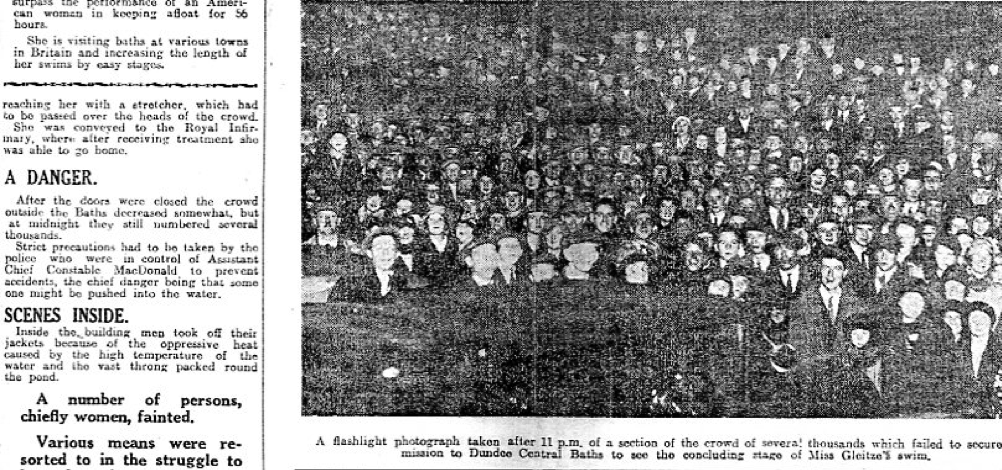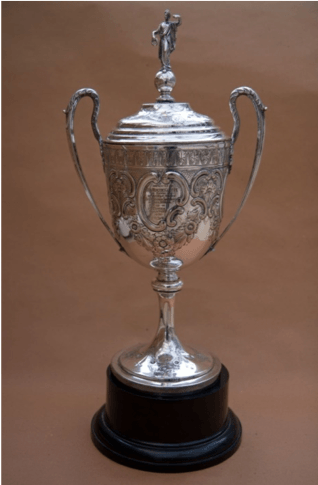Dundee (40½ hours) – 24 to 25 September 1930
Central Baths
The sports-minded citizens of Scotland had already taken Mercedes to their hearts after her Firth of Forth and Loch Ryan swims, as well as her eight attempts to cross the icy North Channel – the last of which had been heartbreakingly close to being successful. Also, people had come in their thousands to watch her at her very first endurance swim in Edinburgh, and so she must have been eagerly looking forward to visiting Scotland once more.
Dundee was one of the Corporations that responded positively to the mail-shot Mercedes had carried out in April, and she received a letter from the Town Clerk’s Office offering her the use of their first class swimming pool. They also informed her that Mr Barry Cuthill, M.I.Mech.E., Engineer and Manager of the Baths Department, would supervise the event at the Dundee Central Baths.
To assist Mr Cuthill, Mercedes had arranged to have official logs of two previous swims forwarded to him for the sake of easy reference, and she asked him to keep them safe until her return from Turkey where she was tackling the Hellespont and the Sea of Marmara.
In a letter to Mercedes nearer the time, Mr Cuthill confirmed that the Amateur Swimming Association had informed him that their members could not assist as stewards or in any other capacity, but that he had made alternative arrangements.
The swim took place from 24 to 25 September, and Barry Cuthill was credited with its successful organisation. The Lord Provost Johnston was present when it started at 8.30 a.m. on Wednesday morning, 24 September, and he and the Lady Provost visited the baths three times in all to check the progress of the swim. A number of town councillors also attended during the final hours.
An electrophone had been installed to provide all the latest jazz music, and Mr Crawford of the Baths Department played pipe music at her request during the swim. On the second day Harry Smead and his Band from the New Palais entertained the crowd during the early part of the evening, and Dave Buist and his Band from the West End Palais de Dance played selections to the crowds during the latter part.
Over the two days the staff provided Mercedes with hearty Scottish meals during the swim – bacon, eggs, bread and coffee for breakfast and a ‘proper’ meal of beef, potatoes and beans for lunch. Apart from that she had her usual liquid refreshments, with an occasional cup of refreshing lemonade that always seemed to revive her.
Media coverage by the Dundee Courier & Advertiser
and the Evening Telegraph & Post
was extensive and supportive, one journalist commenting:
Miss Gleitze is remarkably pretty and swims gracefully without apparent effort. If she continues to go in for endurance tests there is a possibility that she might grow fins!
It was reported that on day one, the pool temperature had been set at 75º, and in circling the pond Mercedes used breaststroke, alternating sometimes with backstroke to relieve her muscles. The daytime hours passed without incident, and the event was well attended. Shortly after ten o’clock much larger numbers of people began to arrive and by midnight the baths were crowded. She was, as usual, very drowsy during the pre-dawn hours, but the dedicated 300 or so spectators who remained on poolside during the long night helped her through. They kept up community singing and the stewards and the audience spoke to her continually to keep her alert. During the daytime and evening of the first day, 3,250 people paid for admission.
On day two Mercedes seemed remarkably fresh throughout the forenoon and afternoon, apart from complaining about a pain in her right foot, which had turned blue. She was given Vaseline to rub in both feet and the temperature of the water was raised to 84ºF. There was a steady flow of spectators during the day, and the Lord Provost and Lady Provost called in on the second of their three visits to see how she was progressing.
Unprecedented scenes
Journalists who covered the afternoon and evening sessions reported that scenes unprecedented in the history of swimming in Dundee were witnessed in the vicinity of the baths towards the conclusion of the swim. Nothing like this mammoth crowd had ever before been housed in the building. The seating areas were full to capacity and hundreds sat around the very edge of the pond. Many spectators sacrificed comfort to get a better view by sitting on the top of bathing cubicle doors, whilst others more daring perched themselves high up on the diving ladder. Strict precautions had to be taken by the police, who were in the control of Assistant Chief Constable MacDonald, to prevent accidents, the chief danger being that someone might be pushed into the water. It was, however, a cheery crowd, and they helped Mercedes along with their community singing.
While this was going on inside, there was an equally amazing scene outside. The queue for the ‘sixpenny doors after ten o’clock’ had begun to form in the late afternoon. As early as four o’clock crowds flocked down to the harbour, many armed with books and food, ready to sit it out. By ten o’clock, queues – several deep – encircled the entire building, and in addition thousands stood along the West Protection Wall and in front of the Unicorn, hoping to gain admittance. Turned away from the front of the queue with the assurance that there was no hope of getting in, many returned to the end of it and stood till after midnight, still hopeful. However, the doors to the pool were shut at ten o’clock after 4,750 had paid for admission (making a total 8,000 over the two days).
Thousands of people – as many as would have filled the building twice over – disappointed at not gaining admission, clamoured around the main entrance, and a special squad of police, large as it was, had a hectic time preventing them from gaining access by sheer force of numbers.
About half past eleven an attempt was made to burst open the north-west door of the pool but the prompt action of the police averted this. About twenty people, however, were successful in reaching the roof of the building, from which vantage point they could look down on the swimmer, while others made a determined attack on a window.
Back inside the baths every inch of space was occupied. The heat was oppressive, and every now and then women and girls were carried out in a fainting condition. From 12.32 a.m. the excitement became intense and almost every action on the part of the swimmer brought forth applause. And at 1.31 a.m. on Friday morning, 26 September, Mercedes was lifted out of the water by three local swimmers amidst terrific cheering from the 2,000-strong crowd. She was taken to an adjoining room where she was examined by a doctor on duty, and then transported by ambulance to the Waverley Hotel in South Union Street, the dense crowd outside giving her a rousing send-off after her success in lengthening her endurance record to 40 hours 30 minutes.

Dundee Courier 26 September 1930 Caption reads: A flashlight photograph taken after 11 p.m. of a section of the crowd of
several thousands which failed to secure admission to Dundee Central Baths to see the concluding stage of Miss Gleitze’s swim.
Newspaper cutting reproduced courtesy of D.C. Thomson & Co. Ltd.
Any forthcoming information about the photographer will be included in future reprints.
By eleven o’clock on Friday morning Mercedes had recovered enough to give an interview to the press sitting up in bed – this in spite of the fact that from an early hour the Waverley Hotel was besieged by admirers, eager to shower congratulations on her. She hadn’t slept much, but nevertheless was feeling very fit. To make up for the lack of sleep she intended to continue resting in bed until tea time, in advance of an evening engagement. She said:
I was delighted with the whole thing. The baths are about the finest I have ever seen in Britain. The arrangements for the swim could not have been better and the crowds were really wonderful. They were so kind and sympathetic to me. And I did love the music.
She also insisted that she could not take sole credit for her successful swim and said the spectators had braced her up no end.
When asked what makes her so sleepy during parts of the swim, she explained: “It is the continual rhythm of swimming in water and the gentle ripple. It is just like when travelling in a train. You know how the continual rhythmic movement makes you feel drowsy.”

She received further gifts of a gold medallion from Mr D. Robertson of the Postal Swimming Club and a silver coffee service from the Dundee Corporation.
Also, on 8 October, Barry Cuthill sent her an inscribed gold pen from the Lord Provost, and at the same time informed her that the log of her Dundee swim has been completed and would be sent to her once it had been signed off.
Published in the People’s Journal, 27 September 1930
Reproduced courtesy of D.C.Thomson & Co. Ltd., Dundee.
